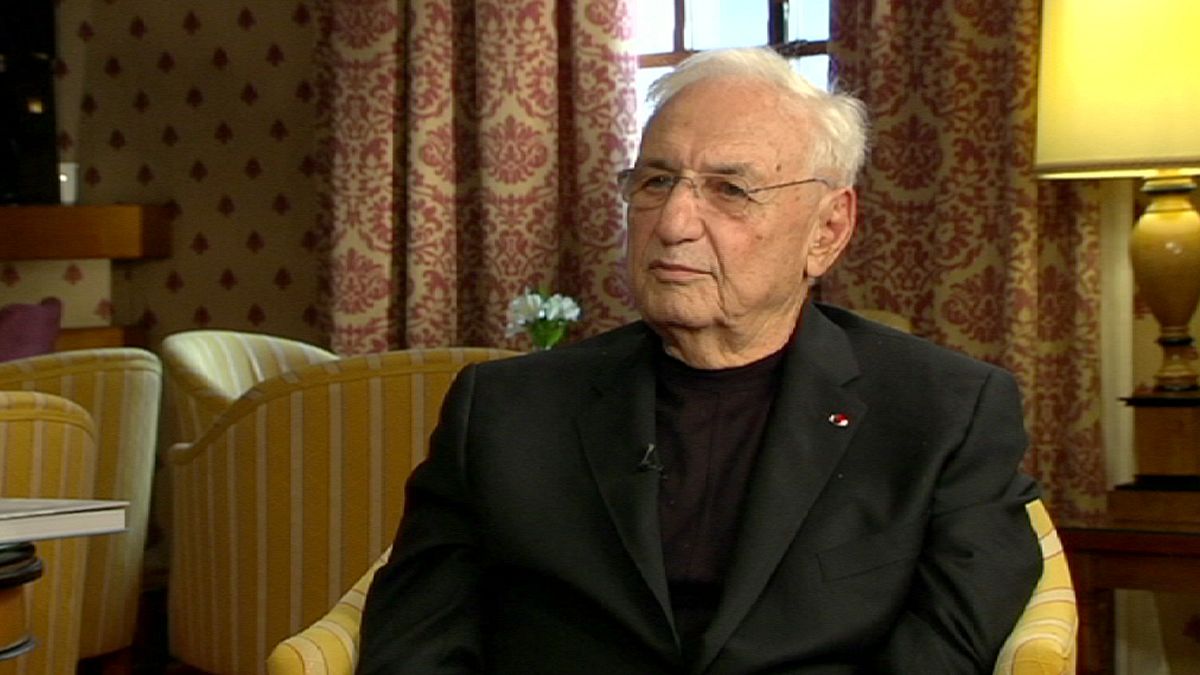Many countries and investors dream of hiring architect of the moment, Frank Gehry.
Euronews spoke to the Canadian-American in Oviedo, Spain, where he has received yet another award in a career already brimming with international accolades.
At 85 years old, the creator of Bilbao's Guggenheim Museum, says he isn’t even considering retiring, but wants to continue making history with extravagant and spectacular buildings.
Javier Villagarcía, euronews: “You just unveiled an impressive new Museum in Paris, while the Pompidou Centre is celebrating your career. Here in Oviedo you have been honoured with the Prince of Asturias Award. How do you feel about so much recognition?
Frank Gehry: “Very suspicious! I work always with a healthy insecurity. So I don’t really believe all this stuff. It’s nice, it feels good, it’s kind of peripheral. I can’t explain it, I don’t know…”
euronews: “The French President, François Hollande, described the Louis Vuitton Foundation as a ‘Cathedral of Light’. Some other guests on the opening night saw a fish, a cloud, a sail boat… What is it, Mr Gehry?”
Frank Gehry: “Everything. There’s all kinds of metaphors, I guess. But I’m a sailor, I do sail, and when you use glass you can’t hang paintings on glass so the real building is inside – it’s a double building – and so it sails throughout the park, kind of.”
euronews: “Where do you get the inspiration to create such an extraordinary building?”
Frank Gehry: “First inspiration is Paris, second is the holiness, the sacredness of the site. The Jardin d'Acclimatation is a 19th-century park – a children’s park – where Proust played, that’s important. I have a client, Bernard Arnault. He is kind of an artist in a way. I know he’s trained as an engineer, but with all his work with the fashion world and so on, he knows how to work with artists, with people who are creative”.
euronews: “We are talking about Bernard Arnault, the LVMH chairman. He commissioned you after a visit to the Guggenheim Museum in Bilbao. How important is that museum in your career?”
Frank Gehry: “Bilbao? Oh my God… I don’t know what percentage, but it was pretty important, I think. The impact, on the city… it changed the city. It was an economic win-win for everybody. And it was modest in price; 80 million euros in 1997. Since then it’s paid back 17 years. The city looks very different now than it did when I first arrived. It’s very prosperous-looking. So I’m very happy about that. It’s a miracle, somehow.”
euronews: “Many cities now would like now their own Guggenheim. Could you, as an architect…”
Frank Gehry: “But, they don’t hire me. They hire other architects to do it. It’s an interesting thing, though, isn’t it? It’s a funny thing. They don’t want one like me, they want another guy to do one… another person… and sometimes they can’t.”
euronews: “So you can, as an architect, promise another city or rich investor the same impact?”
Frank Gehry: “I can’t promise. But it’s been happening a lot. It happened in Disney Hall. It happened in Chicago and the park. Maybe I’m lucky.”
“euronews:” “I’m going to quote you now. You said in a documentary eight years ago: ‘I want to hide under the covers when my buildings open. I’m terrified about what people think.’ Is that still the case?”
Frank Gehry: “Yes! If I step outside myself to other people, sometimes people act very self-importantly when they do a building or do something. I can’t relate to that very easily. Maybe it’s a false modesty, I don’t know.
“It’s just the way I am, I can help it. Because I’m always working on a new building and I call it ‘the healthy insecurity’ that I’m always doing something I’m not sure is going to be any good.
euronews: “I read that some describe your talent as a ‘brilliant madness‘…”
Frank Gehry: Madness! It’s not so mad actually. First of all, I’m a human being, I have human DNA and I can’t escape the limitations of being a human being, I cannot escape. Great artists are always called mad, I guess, so I should be flattered.”
euronews: “You have many projects ongoing now: a new Guggenheim, this time in Abu Dhabi; a Facebook campus in California; the Eisenhower Memorial in Washington. Do you ever think about slowing down, or even retiring?”
Frank Gehry: “I’m thinking about it right now… I’d like to go lie down!
“I don’t know how. I enjoy the work. I enjoy meeting people. I have a nice team. We’ve developped a great team.
“I have a mission, kind of, to re-empower the architect in the equation. Today in the world the architect is less important than a contractor, and I want to put it back so at least the architect should run the project. And I’ve developped computer programmes with Dassault and now with Trimble to eliminate change orders.
“When we did Bilbao, it was really the first real effort at using that software and that process and we saved a lot of money, in a building that will normally be extra for the contractor. So we squeezed it down. And so that gives more power to the architect, it gives me more relevance to allow me to do things, do more expressive buildings.
“The only reason to do more expressive buildings is to humanise them. Dull glass boxes are cold and not friendly to humanity and I am trying to change some of that.”
euronews: “To finish this interview, I’m going to quote you again. You said to the curator of the Louis Vuitton Museum, ‘I made you a violin, now you have to play it’, is that right?
Frank Gehry: “Yes, I did. Yesterday I said that.”
euronews: “Well from euronews, we already thank you for the music. Thank you very much, Mr Gehry.”
